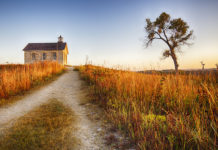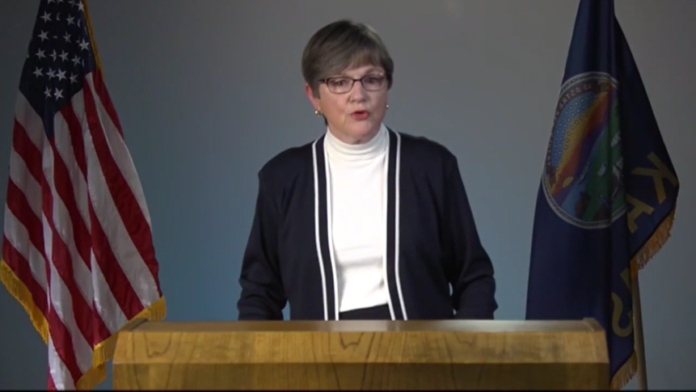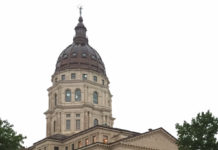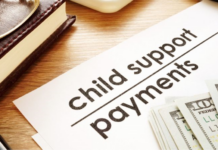(Updated to include comments from the Kansas Chamber of Commerce, Senate President Susan Wagle and House Republican leadership)
Walking a tightrope between “non-negotiable public health considerations” and “jaw-dropping” economic realities, Gov. Laura Kelly on Thursday laid out her plan for gradually bringing the state back to life amid the coronavirus pandemic.
Appearing on statewide television during the dinner hour, Kelly mapped out a phased-in approach to resurrecting an economy that’s suffered with thousands out of work and businesses shut down as the state tried to slow the spread of the virus.
“This is deadly serious, with both lives and livelihoods hanging in the balance,” she said in her address.
“The decisions we make in the coming weeks and months — including the order in which we make them and the pace at which we implement them — will determine what Kansas looks like after this pandemic has run its course,” Kelly said during her nearly 20-minute television address.
Even as Kansas reported 500 new COVID-19 cases on Thursday, Kelly said that state health officials are confident that the state is close to reaching its peak infection rate if it hasn’t already climbed to its apex.
“If that holds, Kansas will soon find itself on the downward side of the slope, and closer than ever to finally flattening that elusive curve we’ve all been talking about for the last two months,” she said.
The governor said gradually reopening the state should not signal local governments to ease up on their safety efforts to control the spread of the virus.
“The state framework should be considered the floor for safeguards — not the ceiling,” she said.
“Local communities are both allowed and strongly encouraged to take additional steps as they deem appropriate.”
The governor’s plan starts with the first phase on May 4, when she will lift the statewide stay-at-home order that has been in place since March 30.
The governor’s plan will still limit mass gatherings to 10 people with restrictions tailored to specific types of businesses.
The state is not imposing a blanket limit on total occupancy but will require businesses to abide by mass-gathering limitations in areas of their establishments where physical distancing is difficult.
Retail stores can reopen in the first phase and so can restaurants with certain limits.
Retaurants can accommodate 10 people at one table so long as the tables are 6 feet apart.
Booths that are back to back would be need to be separated by barriers. Customers also could be seated in every other booth for social distancing.
What’s not be allowed to open in the first phase:
- Bars and night clubs.
- Nontribal casinos.
- Theaters, museums and other indoor leisure spaces.
- Fitness centers and gyms.
- Swimming pools not counting backyard pools.
- Nail salons, barber shops, hair salons, tanning salons, tattoo parlors and other personal services.
- Fairs, festivals, carnivals, parades and graduations.
- Summer camps.
The second phase starts no earlier than May 18, at which point mass gatherings will be limited to 30 people.
The second phase allows for the reopening of fitness centers, gyms, community centers, outdoor pools, nail and hair salons as well a theaters, museums and other indoor leisure spaces.
Casinos will also be allowed to open in the second phase, but only if they comply with uniform guidelines approved by the state health department.
Bars and night clubs will be allowed to open at 50% of total occupancy and can continue operating curbside and carryout services.
Fairs, festivals, carnivals, parades and graduations as well as public and private summer camps cannot operate until the third phase is reached.
Indoor and outdoor entertainment venues with a capacity of 2,000 or more can’t reopen until phase three.
Phase three starts no earlier than June 1, after which mass gatherings will be limited to 90 people and restrictions on business, activities and other venues will be lifted.
Ideally, Kelly said she wants to phase out all restrictions by June 15, assuming the state sees a slowdown in the spread of the virus so long as businesses comply with hygiene and social distancing protocols.
However, Kelly warned that the plan is an evolving an effort that can change as circumstances change.
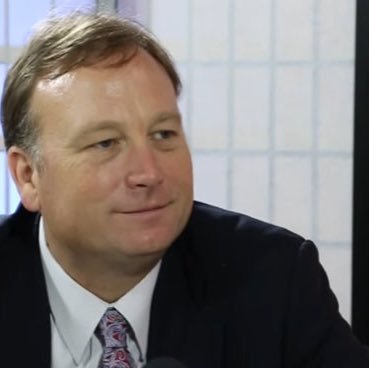
Alan Cobb, president and chief executive officer of the Kansas Chamber of Commerce, said the business community will watch how the governor’s plan develops.
“The chamber will continue to monitor how our state’s health metrics progress in the coming weeks and advocate for additional restrictions to be loosened or eliminated when appropriate, especially for businesses still restricted from opening their doors,” Cobb said in a statement.
“More long-term damage will be done to the Kansas economy the longer all businesses are not allowed to fully operate.”
Senate President Susan Wagle, a candidate for the U.S. Senate, complained that the governor wasn’t moving fast enough to allow businesses to reopen.
Wagle talked generally about businesses that were unhappy with the governor’s plan but did not offer specifics.
“Those that were not allowed to open today are extremely disappointed,” Wagle said.
“Everybody was thinking she was going to take the foot off the metal,” Wagle said. “They thought she would open us up with social distancing. Instead of helping us out, she put her foot on the gas and she implemented restrictions no one expected.”
Like Wagle, House Republican leadership took exception to the fact that the governor’s plan to treats some businesses differently from others.
“Under the governor’s new order, certain small businesses are blocked from re-opening regardless of the safety precautions they take,” House Speaker Ron Ryckman Jr., Majority Leader Dan Hawkins and Speaker Pro Tem Blaine Finch said in a joint statement Thursday night.
The governor emphasized her plan is not a return to the life Kansans knew before COVID-19 started to take hold.
“Tonight’s framework is a starting point for this long, slow transition back to some semblance of the lives we remember from just a few short months ago,” she said.
“I don’t know if life will truly ever go back to normal,” she said.
“After all we’ve been through, we will probably think about everything a little differently in the future – from shaking hands, to going to the grocery store, to how we take care of our own
personal health.”
“But I do know this: we are going to make it through the daunting days ahead, no matter what lies in store.





